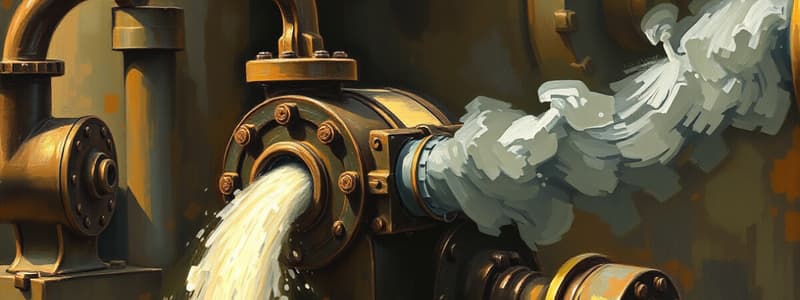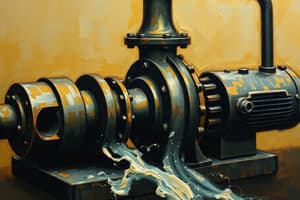Podcast
Questions and Answers
What is the consequence of exceeding the capacity of a pump?
What is the consequence of exceeding the capacity of a pump?
- Enhanced efficiency
- Increased flow rate
- Increased water pressure
- Cavitation (correct)
What should be done immediately after draining the pump?
What should be done immediately after draining the pump?
- Disconnect all hoses
- Operate the positive displacement primer (correct)
- Run the pump at high speed
- Perform maintenance checks
Which of the following is a requirement for supporting automatic sprinkler systems?
Which of the following is a requirement for supporting automatic sprinkler systems?
- Regular testing of all sprinklers
- Using a single water supply source
- Installation of additional sprinkler heads
- Identification of the fire department connection (correct)
Which factor affects the capacity of the pump during operation?
Which factor affects the capacity of the pump during operation?
How is the automatic water supply of sprinkler systems typically designed?
How is the automatic water supply of sprinkler systems typically designed?
What should be identified during preincident planning for sprinkler systems?
What should be identified during preincident planning for sprinkler systems?
What is the primary function of the check valve in the FDC system?
What is the primary function of the check valve in the FDC system?
Which pressure is generally recommended to discharge into the FDC when specific information is unavailable?
Which pressure is generally recommended to discharge into the FDC when specific information is unavailable?
What should be confirmed before a pumper begins to flow water to the FDC?
What should be confirmed before a pumper begins to flow water to the FDC?
What action should the driver/operator take before supplying pressure to the sprinkler system?
What action should the driver/operator take before supplying pressure to the sprinkler system?
What is a potential issue if a sprinkler system activates without a fire?
What is a potential issue if a sprinkler system activates without a fire?
What is the purpose of locating the FDC when the first alarm engine company arrives?
What is the purpose of locating the FDC when the first alarm engine company arrives?
In a combination sprinkler/standpipe system, what should the pressure supplied to the FDC ensure?
In a combination sprinkler/standpipe system, what should the pressure supplied to the FDC ensure?
What might help the driver/operator to determine the required information before pumping to the FDC?
What might help the driver/operator to determine the required information before pumping to the FDC?
What determines whether a standpipe system is classified as wet or dry?
What determines whether a standpipe system is classified as wet or dry?
Which of the following describes a wet standpipe system?
Which of the following describes a wet standpipe system?
What is a significant factor affecting pump discharge pressure in a standpipe system?
What is a significant factor affecting pump discharge pressure in a standpipe system?
Why should a fire department always support the Fire Department Connection (FDC)?
Why should a fire department always support the Fire Department Connection (FDC)?
Which statement about house hose installed at the standpipe connection is true?
Which statement about house hose installed at the standpipe connection is true?
What should firefighters do with closed sprinkler control valves during operation?
What should firefighters do with closed sprinkler control valves during operation?
What is a common misconception regarding the hose lays for standpipes?
What is a common misconception regarding the hose lays for standpipes?
What should the driver/operator do first when water supply or pumping ability is interrupted?
What should the driver/operator do first when water supply or pumping ability is interrupted?
What must be done to a dry pipe system before it can be used for firefighting?
What must be done to a dry pipe system before it can be used for firefighting?
When troubleshooting why a pump is not developing pressure, which step should NOT be taken?
When troubleshooting why a pump is not developing pressure, which step should NOT be taken?
If a charged supply line suddenly loses water, what should be the driver/operator's immediate action?
If a charged supply line suddenly loses water, what should be the driver/operator's immediate action?
Which of the following is NOT a possible reason for a water supply interruption?
Which of the following is NOT a possible reason for a water supply interruption?
How can another driver/operator assist during troubleshooting?
How can another driver/operator assist during troubleshooting?
What is a critical indicator of the pump's operational status?
What is a critical indicator of the pump's operational status?
What common method should be used to trace back a problem with the pump?
What common method should be used to trace back a problem with the pump?
Which document may contain additional troubleshooting information for pump operations?
Which document may contain additional troubleshooting information for pump operations?
What is the primary purpose of pressure-reducing valves in a standpipe system?
What is the primary purpose of pressure-reducing valves in a standpipe system?
What is the recommended maximum pump discharge pressure for standpipe systems?
What is the recommended maximum pump discharge pressure for standpipe systems?
What additional consideration should a firefighter take into account when using a dry standpipe system?
What additional consideration should a firefighter take into account when using a dry standpipe system?
How much pressure is approximately added for each floor above the fire department connection in a standpipe system?
How much pressure is approximately added for each floor above the fire department connection in a standpipe system?
What may happen when water fills a dry standpipe system?
What may happen when water fills a dry standpipe system?
What is a potential risk associated with having numerous open discharge points in a standpipe system?
What is a potential risk associated with having numerous open discharge points in a standpipe system?
Which adaptation may be necessary if the fire department connection (FDC) has a frozen swivel?
Which adaptation may be necessary if the fire department connection (FDC) has a frozen swivel?
Why is it important for the driver/operator to be familiar with the hose and nozzles in use for standpipe operations?
Why is it important for the driver/operator to be familiar with the hose and nozzles in use for standpipe operations?
Flashcards are hidden until you start studying
Study Notes
Equipment Problems
- Inner liner of the intake hose can detach and collapse, blocking water flow.
- Hose may return to original position when vacuum is broken after disconnection.
- Exceeding pump capacity results in cavitation.
Shutting Down the Operation
- Decrease engine speed gradually, disengage pump, and allow draining.
- Operate the positive displacement primer until fluid discharge occurs.
- Flush pump with clean water unless using a static water supply.
Sprinkler and Standpipe Support
- Driver/operator must ensure proper support for sprinkler and standpipe systems.
- Water supply procedure details are outlined in skill sheet 10-7.
Supporting Automatic Sprinkler Systems
- Sprinkler systems are designed to support a limited flow of fire sprinklers simultaneously.
- Fire department must augment water supply during sprinkler activation.
- Preincident planning should identify sprinkler system installations and FDC locations.
- Pump pressure requirements are dependent on local policies.
Immediate Supply of the FDC
- FDC is essential during fires with activated sprinklers; include a siamese connection or a large diameter option.
- Water enters the system via a check valve that prevents reverse flow.
- First arriving engine company identifies the FDC and nearest hydrant; appropriate hoselines must be connected.
Caution
- Ensure safe operating pressure for hoselines during interior operations.
- Confirm fire conditions before supplying water to the FDC.
- Slowly develop pressure after confirming the need for FDC supply.
- Suggested discharge pressure for FDC is generally 150 psi (1,050 kPa).
When Specific Information is Unavailable
- In the absence of specific guidelines, pump 150 psi into the FDC to support automatic sprinkler systems.
Standpipe Systems
- Standpipe systems facilitate quick water supply access for fire attack.
- Fire attack teams connect to designated 2½ inch (65 mm) or 1½ inch (38 mm) lines on each floor.
- Wet systems have water available immediately, while dry systems require charging.
Supporting Standpipe Systems
- Firefighters must check sprinkler control valves; any closed valves should be opened.
- Pressure losses due to zoning and elevation need consideration during operations.
Standpipe Calculations
- Nozzle and elevation pressures, along with friction loss, must be accounted for.
- Do not exceed pump discharge pressures of 185 psi (1,300 kPa) unless system and hose specifications allow.
Pressure-Reducing Valves
- Use total height for elevation pressure calculations with pressure-reducing valves in the system.
- Potential vandalism may pose a risk; verify valve statuses during incidents.
Troubleshooting
- Promptly address any indication of water supply issues by notifying the Incident Commander.
- Logically trace problems from the pump back to potential sources.
- Collaborate with other firefighters to troubleshoot supply interruptions or mechanical failures.
- A flowchart may assist in troubleshooting pump and operational issues.
Studying That Suits You
Use AI to generate personalized quizzes and flashcards to suit your learning preferences.




